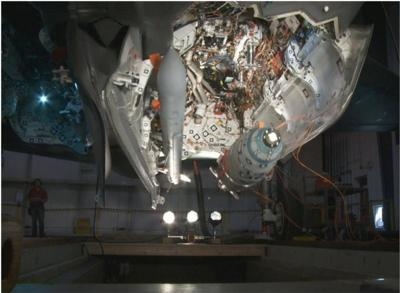Fri, Apr 20, 2012
NAVAIR Completes Testing Of Nine Weapons Combinations
After ejecting a 500-pound bomb from F-35B test aircraft BF-3, the test team took a collective breath, and watched as it hurtled toward the concrete deck.

Coming to rest in the foam covering the pit floor, the March 29 “pit drop” marked the end of two weeks of testing nine different weapons combinations inside the Joint Strike Fighter’s two internal weapons bays. “Completion of these weapons ejections into the pit gets us closer to in-flight release of weapons from the F-35,” said Navy Capt. Erik Etz, director of test and evaluation for F-35 naval variants. “It’s another step in expansion of the F-35’s warfighting capabilities.”
Weapons pit-drop testing collects data to measure stresses on the airframe and adjacent stores, ensures proper weapon and suspension equipment function, and validates the separation models for the munitions’ ejection characteristics, including trajectories and velocities. “We pushed the team pretty hard on those runs to get everything done,” said John Fahnestock, lead government weapons engineer. “We’ll spend some time going through the data to validate our models, but so far it looks good.”
From the cockpit, the pit drops demonstrated minimal effects of weapons launches from the F-35B’s left and right internal bays. “Having the test weapons on board isn't really noticeable from the seat,” said Marine Corps test pilot Lt. Col. Matthew Taylor. “But what’s great about the team’s accomplishment is that we’re making progress toward delivering a warfighting aircraft to the fleet.”
Testing included inert versions of the GBU-12 Laser-Guided Bomb, the 1,000-pound GBU-32 Joint Direct Attack Munition and the AIM-120 Advanced Medium-Range Air-to-Air Missile. More weapons testing on the F-35B and F-35C carrier variant is ongoing at Naval Air Station Patuxent River. Current test events including pit drops, captive carry and instrumented weapons environmental flights, lead up to flight separation testing scheduled for later this year.
The F-35B variant of the Joint Strike Fighter for the U.S. Marine Corps is capable of short take-offs and vertical landings for use on amphibious ships or expeditionary airfields to provide air power to the Marine Air-Ground Task Force. The F-35B is undergoing test and evaluation at NAS Patuxent River prior to delivery to the fleet.
More News
“We achieved full mission success today, and I am so proud of the team. It turns out Never Tell Me The Odds had perfect odds—never before in history has a booster this >[...]
NonDirectional Beacon An L/MF or UHF radio beacon transmitting nondirectional signals whereby the pilot of an aircraft equipped with direction finding equipment can determine his/h>[...]
About 5ft Above Ground Level, The Airplane Stalled, And The Left Wing Dropped Analysis: The pilot reported that this flight was conducted as part of phase 1 flight testing of the n>[...]
Aero Linx: Brodhead Pietenpol Association The Brodhead Pietenpol Association is a newly reorganized (in 2017) non-profit educational corporation that grew and developed from an ear>[...]
Also: VerdeGo Contract, Medi-Carrier, Gambit 6 UCAV, Blade Urban Air Mobility Pilot Archer Aviation has inked a deal for control of Hawthorne Municipal Airport (HHR), also known as>[...]
 Aero-News: Quote of the Day (11.17.25)
Aero-News: Quote of the Day (11.17.25) ANN's Daily Aero-Term (11.17.25): NonDirectional Beacon
ANN's Daily Aero-Term (11.17.25): NonDirectional Beacon NTSB Final Report: Fred L Wellman CH 750 Cruzer
NTSB Final Report: Fred L Wellman CH 750 Cruzer ANN's Daily Aero-Linx (11.17.25)
ANN's Daily Aero-Linx (11.17.25) Airborne-NextGen 11.11.25: Archer Buys Hawthorne, Joby Conforms, Stranded Astros
Airborne-NextGen 11.11.25: Archer Buys Hawthorne, Joby Conforms, Stranded Astros



